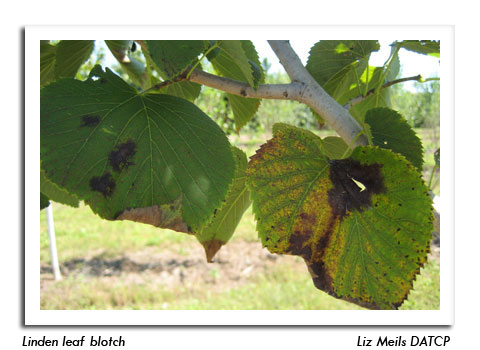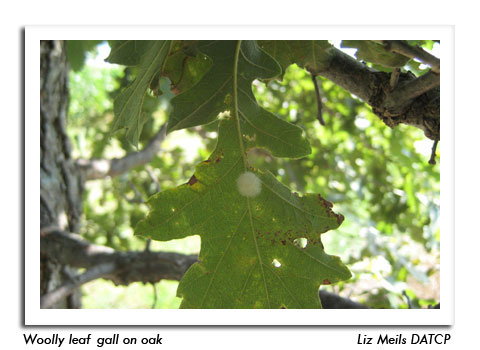
 |
|
|
Nursery & Forest
Volume 56 Number 19 Date 09/01/2011 LINDEN LEAF BLOTCH - A light infection on American lindens was noted at a nursery in Dane County. The brownish-black leaf spots with feathery margins characteristic of this disease develop in later summer, although the spores infect the leaves in early spring. The occurrence of this and other leaf spot diseases late in the growing season generally does not seriously affect the health of a tree. Nursery operators and homeowners who wish to reduce the occurrence of leaf spots next year should remove all fallen leaves at the end of the season and use practices that reduce moisture in the tree canopy. ARBORVITAE LEAFMINER - Arborvitae varieties at nurseries in Dane, Racine and Waukesha counties are showing hollowed, browned foliage tips caused by this leaf miner. The larvae will overwinter in arborvitae foliage, pupate in spring, and emerge as moths next June. Damage resulting from the larval stages of this insect first appears in late January or February and is commonly misdiagnosed as winter injury. Severe infestations can be treated with a systemic insecticide in fall or early spring, although control is usually unnecessary. OAK GALLS - Nursery inspections in the past week found an assortment of galls, including noxious oak gall on swamp white oak in Dane County and various leaf galls in Waukesha County. Galls are abnormal outgrowths of plant tissue caused by insects, fungi, bacteria, nematodes or mites. These growths may develop on any plant part, but most commonly occur on the branches and leaves. Chemical treatment should be timed to control the adult stage, if justified. Pruning and destroying infested plant parts is the preferred control method. --Liz Meils, DATCP Nursery Inspector GYPSY MOTH - This pest has been substantially less of a threat than had been anticipated. Larval populations were mostly light this year and no noticeable defoliation was detected by aerial surveillance. In addition, areas of the state that suffered heavy defoliation in 2010 showed little or no tree mortality. Gypsy moth larvae defoliated 346,749 forested acres last season, greatly surpassing the previous record of 65,000 acres set in 2003. REDHEADED PINE SAWFLY - Moderate to heavy damage affecting 40,000 acres of young jack pines has been reported in portions of Burnett and Washburn counties. Redheaded pine sawfly larvae periodically reach outbreak levels and are a standard defoliator of jack pines in northern Wisconsin. RHIZOSPHAERA NEEDLE CAST - Severe browning of spruce trees in nurseries and forested areas throughout the state has largely been attributed to this needle cast disease. Symptoms may develop on trees of any age and gradually progress from the lower to upper branches. Repeated needle loss results in branch death after 3-4 years. Development of this and other conifer fungal diseases is favored by cool, wet spring weather conditions. Rhizosphaera has been very prevalent this season. OAK LACE BUG - These small, "true bugs" are causing severe bronzing of oak leaves in Douglas and Washburn counties. The symptoms should persist through fall, but long-term damage is not expected. --Krista Hamilton, DATCP Entomologist (information from the DNR Northern Region Forest Health Specialists) 




|
|
|